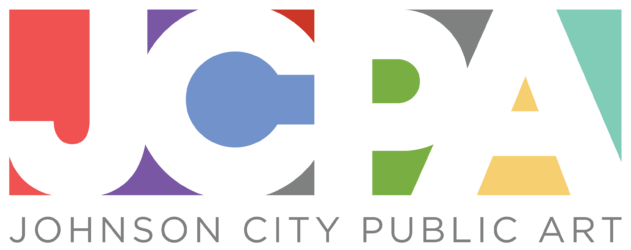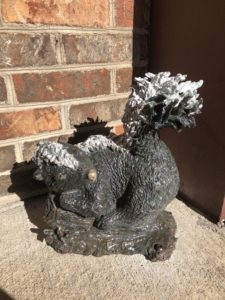Click to view larger image
Angelique Fraley is an instructor in the ETSU Department of Art & Design who chose a skunk as the model for the bronze sculpture she made for the downtown scavenger hunt “Wildabout Walkabout.” She believed that recreating the texture of the skunk’s fur would pose an interesting challenge and its stripe would allow her to work on the sculpture’s patina, which is a specialty of hers. Patina is the “skin” of the sculpture produced naturally by oxidation and age or created in the studio by various combinations of chemical compounds, heat and polishing.
Like the “Quilted Owl” near the Public Library that Angelique created for the JC Biennial Sculpture Exhibition, the skunk has a foam base at its core. Unlike the owl, whose core is covered in many pounds of concrete, the skunk was next coated in wax. The wax used in “lost wax” bronze casting is a petroleum-based product that can be hard or soft, or some combination of the two. Angelique used a paintbrush to build up many layers of melted wax over the skunk’s form. She also used a heat gun and torch to sculpt the shape. To achieve the texture of the tail, she dipped paper towels in melted wax and placed them over the basic form of the tail.
Casting a bronze sculpture is a test of creative endurance that requires something like 27 separate steps. After building vents around the sculpture to channel the flow of the liquid metal, Angelique began working on the ceramic coating that surrounds the form. Over the course of two or three weeks, she built up seven or eight coats of slurry that was layered between coats of sand and silica and allowed to dry between coats. The mold is then hung upside down in a 900-1000 degree oven to allow the wax to come out of the shell. The mold is then repaired and patched, if necessary.
It takes three to four hours for the furnace to bring bronze to its melting point. The mold needs to be hot and dry when the molten bronze is poured. After a day of cooling, the mold is removed, the metal form is sanded, ground, and polished and the patina is applied. Finally, it’s coated in wax and sealed.
Angelique is a native of Jonesborough and earned both her BFA and MFA from ETSU. She works in all mediums and uses a variety of materials in her work. In addition to her teaching duties at ETSU, Angelique has taught in the “Artful Aging” program at the library. She’s thrilled to be a part of what Johnson City is trying to achieve through its public art program, establishing art as a form of collective community expression.


